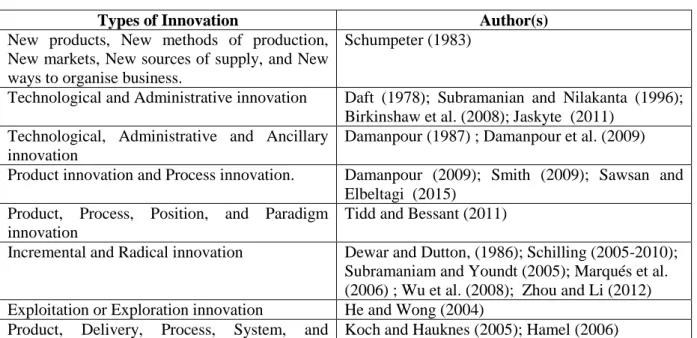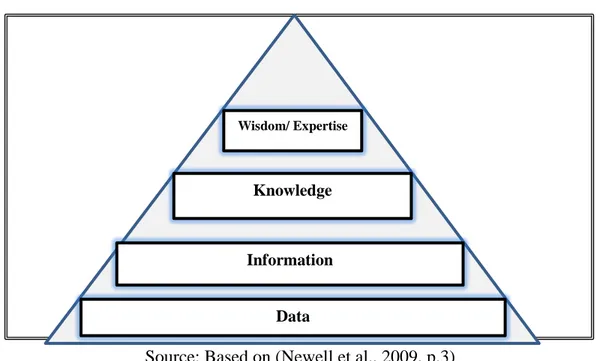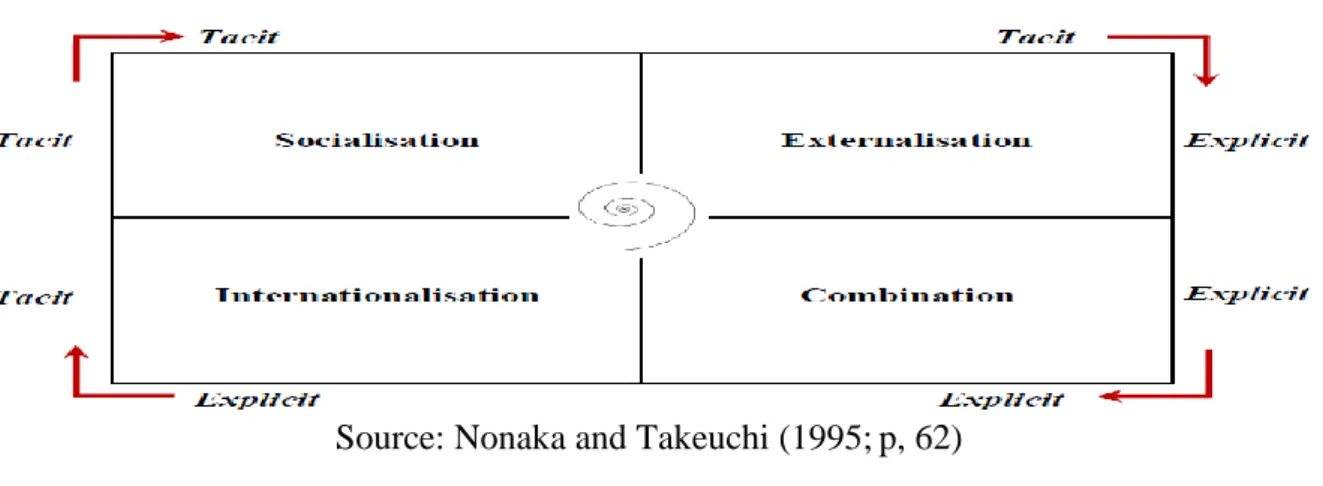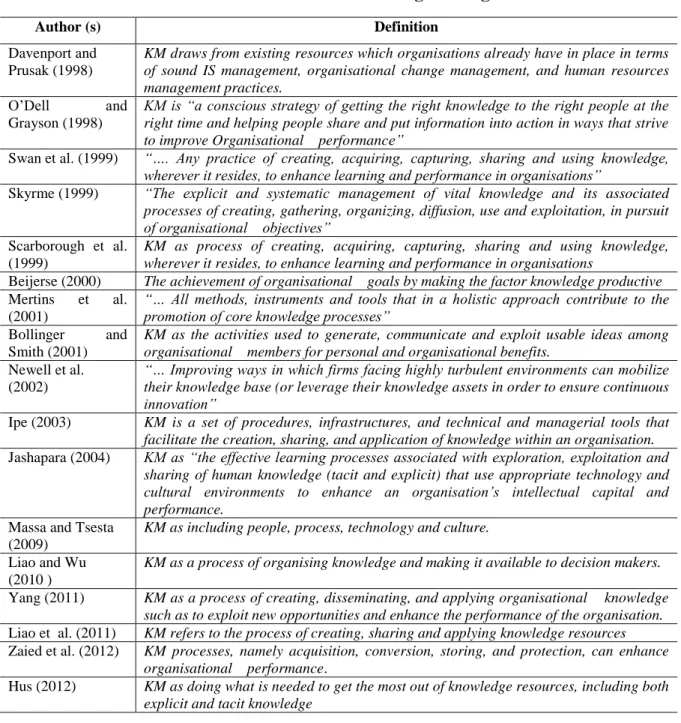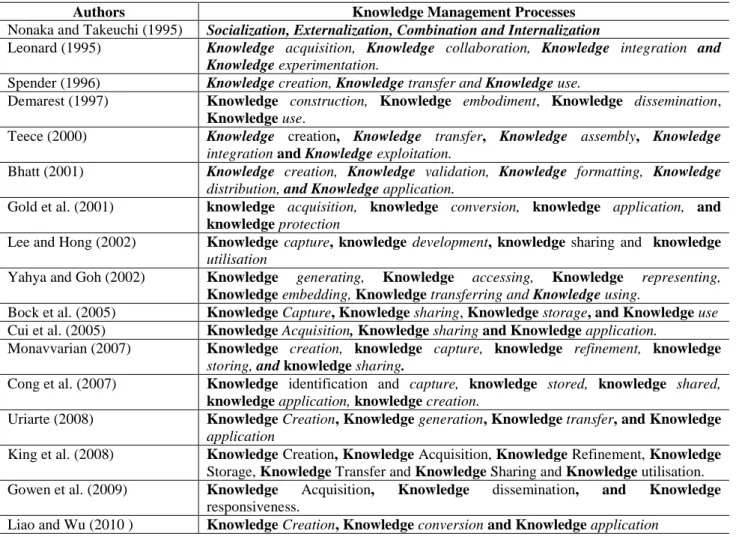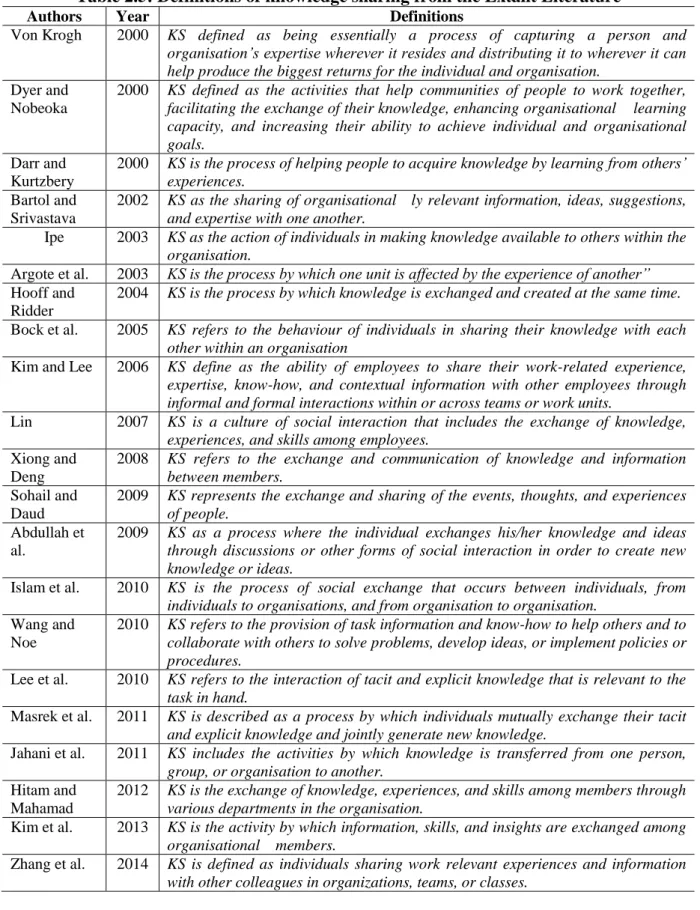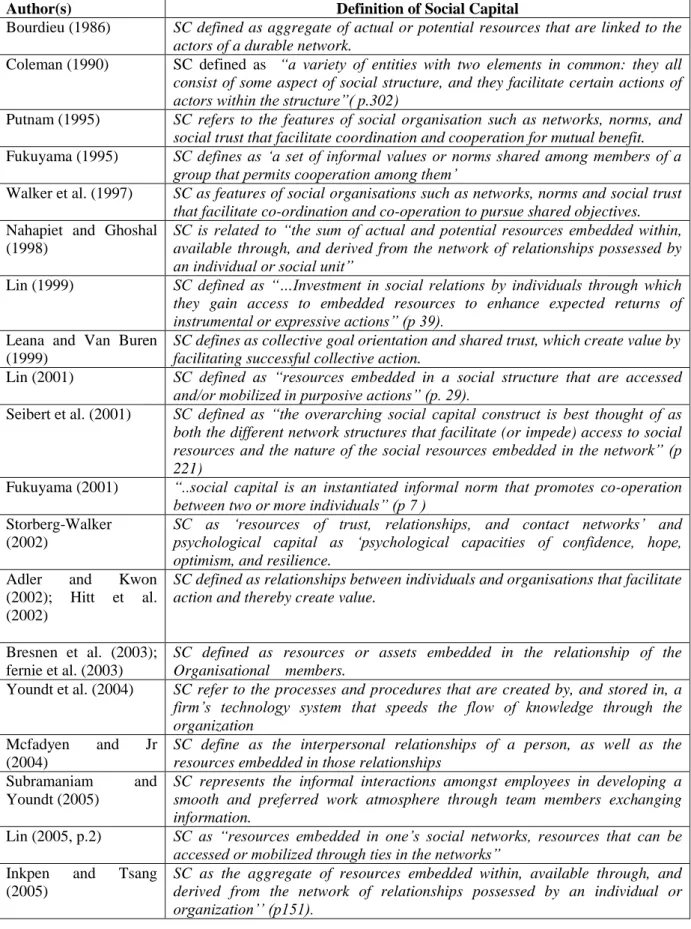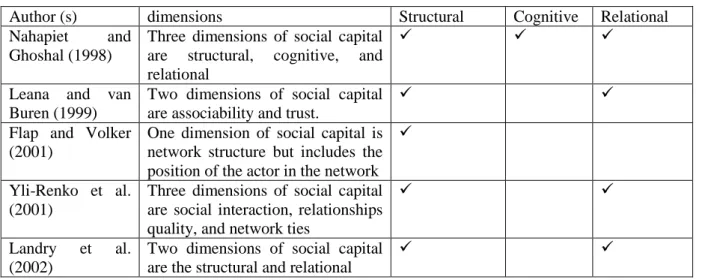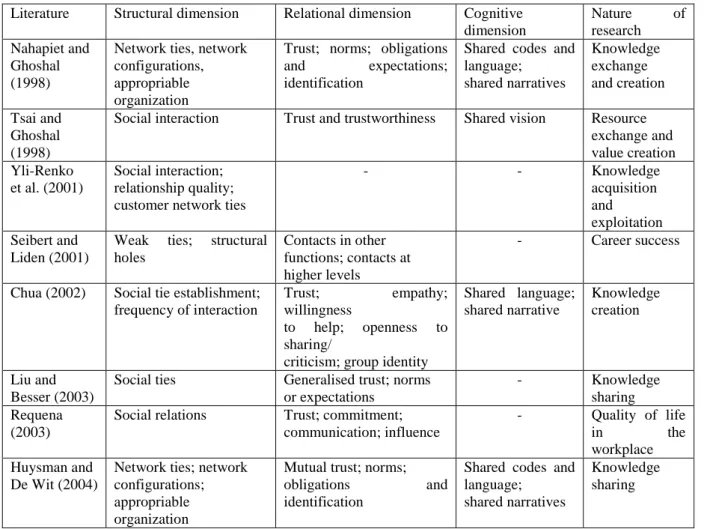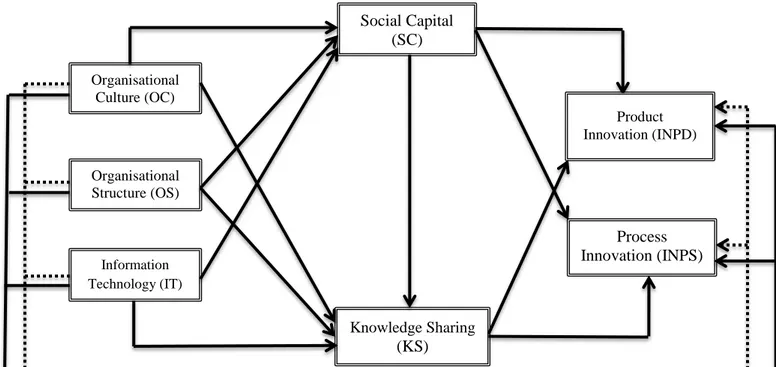I
Copyright Statement
This copy of the thesis has been supplied on condition that anyone who consults it is understood to recognise that its copyright rests with its author and that no quotation from the thesis and no information derived from it may be published without the author's prior consent.
II
THE IMPACT OF ORGANISATIONAL CONTEXT ON INNOVATION
IN LIBYAN’s PUBLIC AND PRIVATE OIL SECTORS: THE ROLE OF
SOCIAL CAPITAL AND KNOWLEDGE SHARING.
By
IBRAHEM BELKASEM MOHAMED ALHAJ
BA, MSc, PGC
A thesis submitted to Plymouth University
in partial fulfilment for the degree of
DOCTOR OF PHILOSPHY
Graduate School of Management
III
THE IMPACT OF ORGANISATIONAL CONTEXT ON INNOVATION IN LIBYAN’s PUBLIC AND PRIVATE OIL SECTORS: THE ROLE OF SOCIAL CAPITAL AND
KNOWLEDGE SHARING
By
Ibrahem Belkasem Alhaj
Abstract
It has been recognised that the oil sector in developing countries is facing challenges from a dynamic environment characterised by rapid technological change and increased demand. As innovation becomes critical to the survival of organisations, organisational context including organisational culture (OC), structure (OS) and information technology (IT) has been found to have an important influence on innovation, leading to increase social relationships among employees and flow knowledge within organisation through face to face employees interaction and information system.
Social capital and knowledge sharing are recognised as the most significant resources for competitive advantage and the key to enhancing innovation. It has long been argued that social capital, a concept represented by the value embedded in the social relationships of individuals and collectives constitute strategic resources for individuals and organisations. Social networks perceived by individuals are a key issue in generating and facilitating knowledge sharing among employees to enhance innovation within organizations. It has also been shown that knowledge management and the promotion of knowledge sharing among the members of an organisation are an important part of the learning process as they help to convert the tacit knowledge embedded in individuals into explicit knowledge through interaction. Prior literature has pointed out that organisational context is one of the most important factors affecting social capital and knowledge sharing and enhanced innovation in an organisation. However, there is a lack of models linking organisational context, social capital and knowledge sharing, and innovation within oil sectors in general within developing countries, particularly Libya.
Against this background, the thesis investigates the impact of organisational context on innovation. Using social capital and knowledge sharing, the integrative and comprehensive conceptual model are developed in order to reveal the direct and indirect impacts of organisational context on innovation. The model is then tested with a sample of 418 employees from two sectors; namely, public and the private. These were analysed through a
IV
multivariate analysis using a variance-based statistical technique known as Partial Least Squares Structural Equation Modelling.
The findings of this thesis are three-fold. First, with respect to the direct effect of organisational context on innovation, the study finds that both public and private sectors’ innovation are positively affected by organisational context. Second, regarding the indirect impact of organisational context on innovation, the study confirms its indirect nature through the social capital and knowledge sharing in both sectors. Third, the results show that there are significant differences between the public and private oil sectors in terms of the effect of organisational context on social capital, knowledge sharing and innovation, product and process.
These findings have both theoretical and practical implications in that the results have provided empirical evidence on the direct and indirect impact of organisational context and can serve as an indication in practice for both firm managers and policy makers who are looking to establish strategies for achieving innovation. These would benefit from expending their efforts on promoting social capital and knowledge-sharing practices among their employees.
V
Author’s declaration
At no time during the registration for the degree of Doctor of Philosophy has the author been registered for any other university award.
Working Papers:
Alhaj, I. & Haddoud, Y. Organisational Context and Innovation: A Comparison Study between Libyan Public and Private Oil Sectors (In-Progress).
Alhaj, I. & Haddoud, Y. Examining Social Capital and Knowledge Sharing as Antecedents of Product and Process Innovation in Libyan Public and Private Oil Sectors: an application of the resource-based view (RBV) theory, (In-Progress).
Alhaj, I. & Haddoud, Y. Organisational Context and Innovation: the Role of Knowledge Sharing in Libyan Public Oil Sectors (In-Progress).
The following activities were undertaken in connection with the programme of the study: Participated in the Plymouth University Postgraduate 2013, presented a poster on
"Knowledge sharing Practices in Libyan oil sectors”.
Attended and completed the General Teaching Associates (GTA) Certificate, 2011, from Plymouth University.
Attended Postgraduate Certificate in Research Methodology, 2013, Plymouth University.
Attended PG Society Conference 2014, Plymouth University.
Attended International Entrepreneur Conference 2014, Plymouth University.
Attended leading with questions across cultures event, Plymouth University.
Attended Research Students Skills Development Programmes held at the Plymouth University (Research Methods, Transfer Process, Presentation Skill, Endnote for beginners, Using NVivo for analysis, Using SPSS for analysis, Structuring your Thesis,
Introduction to EndNote, Writing Literature Review, Writing Zone, Academic English and critical thinking, Introduction to R, Public engagement, Making Progress - Avoiding defeatism and self-sabotage, GIS an Introduction, Presenting to an Audience part 2, SPSS, Plagiarism, Introduction to Applying for research funding, Leadership and Management: Selection Interviewing).
Word count of main body of thesis: 79,710 Signed Date 01/04/2016
VI
Dedication
I dedicate this thesis to
To the soul of Dr Ibrahim Elbeltagi who supported me
To my mother and father who consented extraordinary sacrifices to help me fulfil my aspirations. To my brothers and sisters,
To my wife
She is the inspiration for my writing and my life. Without having her as a wife, supporter, and friend in my life, I would not have been able to study long hours to finish my PhD. I appreciate all her sacrifices. Thank you from the bottom of my heart
for being there for me
To my children: Yazen and Qaise
Yazen and Qaise are the source of my joy and happiness; without their smile I could not have overcome the stress and difficulties of my PhD.
A special dedication to my supervisors, Dr Mohamed Haddoud and Prof Kaled Hussainey
VII
Acknowledgments
This thesis has been a long and challenging journey, yet truly enjoyable. I owe a debt of gratitude to many. First and foremost, all thanks to Allah for assisting me in the completion of this thesis; without His guidance and grace this research would not have been completed.
I am eternally grateful to my dear parents for their endless love, care and attention. I cannot thank them enough for their moral and parental support throughout the duration of my study. To appreciate your love, care, and support, I have always studied hard and have been ever respectful, may Allah bless your efforts abundantly. I will not forget my brothers, sisters and their chilidern for their love and unconditional support.
I would like to thank my wife for her continuous moral support and encouragement, patience, sacrifice and enthusiasm during my study. I am very grateful to her. Without that, the completion of this thesis would have probably taken much longer. Last, but by no means least. I am very grateful to her. My children, Yazean and Qaise, have kept me cheerful all the time by their playfulness, smile and laughter. I love them dearly and I hope they will be successful in their life.
My special thanks goes to soul of Dr. Ibrahim Elbeltagi for his unforgettable advises which I am sure will live with me until my death. May Allah keeps his soul in peace and grants him the mercy.
I wish to give special thanks and to express on my sincerest gratitude to my supervisors, Dr. Mohamed Haddoud and Professor Khaled Hussainey. You have been exceptionally supportive and generous with your time and knowledge during my journey. Without your guidance and critical feedback, this research would have been impossible. You have both been top class supervisors; you have always been available to answer my “quick questions” at midnight and on Sundays. You have been constantly encouraging during the tough times of my PhD journey. I will never forget your endless support, you are inspiring academics to me and my wish is to one day be as good a researcher and a supervisor as you are.
I would like to take the opportunity to express my thanks to the following special individuals: Prof. Philip Megick, Mrs. Beryl Badger, Prof. Salima Paul and Dr. Gauci for their support and encouragement during my PhD journey.
VIII
I gratefully acknowledge the financial support given to me from the Libyan Ministry of Education. Special thanks also should go to all administrative and academic staff in Department of Business and Management, Faculty of economic, Zawia University for their moral support.
I am delighted to give my special appreciation to all administrative and academic staff in Plymouth business School for their support. I would like also to express my special thanks to my friends and colleagues for your kindness and endless support.
IX
Contents
Abstract ... III Author’s declaration... V Dedication ... VI Acknowledgments... VII List of Tables ... XVI List of Figures ... XVIII List of Abbreviations ... XIXCHAPTER ONE: INTRODUCTION ... 1
1.0 Introduction ... 1
1.1 Research Background ... 1
1.2. Research Gaps and Contributions ... 8
1.3. Research Aim and Objectives ... 13
1.4. Significance of the Research ... 14
1.5. Research Context ... 16
1.6 The Structure of the Thesis ... 18
CHAPTER TWO: LITERATURE REVIEW ... 21
2.0 Introduction ... 21
2.1 Innovation ... 21
2.1.1 Definition of Innovation ... 23
2.1.2 Types of Innovation ... 27
2.1.3 The Importance of Product and Process Innovation ... 32
2.1.3.1 Product Innovation (PDIN) ... 35
2.1.3.2 Process Innovation (PSIN) ... 36
2.2. Determinants of Innovation: Knowledge Sharing and Social Capital ... 39
2.2.1 Theoretical Basis ... 39
2.2.1.1 A Resources-Based View Approach ... 40
2.2.1.2 A Knowledge -Based View Approach ... 43
2.2.2 Knowledge Sharing ... 47
2.2.2.1 Knowledge and Knowledge Management ... 47
2.2.2.2 What is Knowledge? The Knowledge Hierarchy ... 48
2.2.2.3 Types of Knowledge ... 50
X
2.2.2.5 Definitions of Knowledge Sharing ... 59
2.2.2.6 Knowledge Sharing Process ... 62
2.2.2.7 The Importance of Knowledge Sharing for Innovation ... 65
2.2.3 Social Capital ... 68
2.2.3.1 Definitions of Social Capital ... 69
2.2.3.2 The Components of Social Capital ... 73
2.2.3.3 The Importance of Social Capital for Innovation ... 85
2.2.4 The Importance of Social Capital for Knowledge Sharing ... 86
2.2.5 Knowledge Sharing and Social Capital in Public and Private Organisations ... 89
2.3. Organisational Context ... 95
2.3.1 Definitions of Organisational Culture ... 96
2.3.2 Dimensions of Organisational Culture ... 100
2.3.3 Definitions of Organisational Structure ... 102
2.3.4 Dimensions of Organisational Structure ... 104
2.3.5 Definitions of Information Technology ... 108
2.3.6 Dimensions of Information Technology ... 110
2.3.7 The Importance of Organisational Context for Innovation ... 114
2.3.7.1 Organisational Culture and Innovation ... 114
2.3.7.2 Organisational Structure and Innovation ... 116
2.3.7.3 Information Technology and Innovation ... 117
2.3.8 The Importance of Organisational Context for Knowledge Sharing ... 118
2.3.8.1 The Importance of Organisational Culture for Knowledge Sharing ... 118
2.3.8.2 The Importance of Organisational Strcture for Knowledge Sharing ... 120
2.3.8.3 The Importance of Information Technology for Knowledge Sharing ... 121
2.3.9 The Importance of Organisational Context for Social Capital ... 122
2.3.9.1 Organisational Culture and Social Capital ... 122
2.3.9.2 Organisational Structure and Social Capital ... 122
2.3.9.3 Information Technology and Social Capital ... 124
2.3.10. Identified Gaps in the Literature ... 127
2.4. Chapter Summary ... 134
CHAPTER THREE: THE CONCEPTUAL FRAMEWORK ... 137
3.0 Introduction ... 137
XI
3.2 Model Development and Research Hypotheses ... 139
3.2.1The Relationship between Organisational Context and Social Capital ... 140
3.2.1.1 Organisational Culture and Social Capital ... 140
3.2.1.2 Organisational Structure and Social Capital ... 140
3.2.1.3 Information Technology and Social Capital ... 141
3.2.2 Organisational Context and Knowledge Sharing ... 142
3.2.2.1 Organisational Culture and Knowledge Sharing ... 142
3.2.2.2 Organisational Structure and Knowledge Sharing ... 145
3.2.2.3 Information Technology and Knowledge Sharing ... 148
3.2.3 The Relationship between Social Capital and Knowledge Sharing ... 151
3.2.4 The Relationship between Social Capital and Innovation ... 154
3.2.5 The Relationship between Knowledge Sharing and Innovation ... 157
3.2.6 Organisational Context and Innovation... 163
3.2.6.1 Organisational Culture and Innovation ... 163
3.2.6.2 Organisational Structure and Innovation ... 165
3.2.6.3 Information Technology and Innovation ... 166
3.2.7 The Mediating Effect of Social Capital in the Organisational Context- Innovation Relationship ... 168
3.2.8 The Mediating Effect of Knowledge Sharing in the Organisational Context- Innovation Relationship ... 170
3.3 Summary of Hypotheses Statements ... 172
3.4 Summary of the Chapter ... 174
CHAPTER FOUR: RESEARCH CONTEXT ... 176
4.0. Introduction ... 176
4.1 Historical Background and Political Changes ... 177
4.2 Economic Environment ... 180
4.3 Oil Company Profiles ... 186
4.4 Libyan Social Culture ... 189
4.5 Technological Environment ... 200
4.6 Conclusion ... 202
CHAPTER FIVE: RESEARCH METHODOLOGY AND METHODS ... 204
5.0. Introduction ... 204
5.1 Research Philosophy ... 204
XII
5.3 Research Approach ... 210
5.4 Research Methodology ... 213
5.5 Research Design... 213
5.6 The Use of Survey Method ... 215
5.7 Survey Population and Employees Selection ... 217
5.8 Data Collection Procedure ... 219
5.9 Questionnaire Design and Measures ... 221
5.10 Layout of Questionnaire ... 222
5.11 Translation of Questionnaire... 225
5.12 Ethical Considerations ... 226
5.13 Measurement Variables ... 227
5.13.1 The Independent Variables... 229
5.13.1.1 Organisational Culture ... 229
5.13.1.2 Organisational Structure ... 230
5.13.1.3 Information Technology ... 231
5.13.2 The Dependant Variables ... 231
5.13.3 The Mediating Variables ... 233
5.13.3.1 Social Capital ... 233
5.13.3.2 Knowledge Sharing ... 235
5.14 The Use of PLS –SEM ... 236
5.15 Pilot Testing ... 239
5.15.1 Content Validity ... 240
5.15.2 Construct Validity and Reliability ... 241
5.16. Response Rate ... 244
5.17 Chapter Summary ... 246
CHAPTER SIX: DATA ANALYSIS AND FINDINGS ... 249
6.0 Introduction ... 249 6.1. Descriptive Statistics ... 249 6.1.1. Sample Characteristics’ ... 250 6.1.1.1 Employees’ Gender ... 251 6.1.1.2 Employees’ Age ... 251 6.1.1.3 Employees’ Experience ... 252
XIII
6.1.1.5 Employees’ Position ... 254
6.1.2. Data Distribution ... 255
6.1.3. Testing for Non-Response Bias... 255
6.1.4. Missing Data and Outliers ... 257
6.1.5. Common Method Bias ... 258
6.2. The PLS-SEM Analysis ... 259
6.2.1. Determining the Nature of the Constructs... 261
6.2.2. Measurement Model of the Reflective First Order Constructs ... 263
6.2.2.1 Individual item reliability ... 263
6.2.2.2 Constructs’ reliability ... 266
6.2.2.3 Constructs’ Validity ... 267
6.2.2.4 Collinearity test... 270
6.2.3. Measurement Model of the Formative Second Order Constructs ... 270
6.2.4. The Structural Model Results ... 273
6.2.4.1 Model fit indices ... 274
6.2.4.2 The path analysis (structural relationships) ... 275
6.3. Direct and Indirect Effects (Mediation Test) ... 284
6.4. Further Analysis ... 291
6.5. Public and Private Sector Comparison ... 293
6.6. Summary of the Results and Hypotheses Testing... 298
6.7 Chapter Summary ... 309
CHAPTER SEVEN: DISCUSSION ... 311
7.0 Introduction ... 311
7.1. The Research Gaps, Model and Research Questions... 311
7.2 The direct Impact of Organisational Context (OC, OS and IT) on Product and Process Innovation (RQ1) ... 316
7.3. Organisational Context Increasing Product and Process Innovation through Social Capital (RQ2) ... 319
7.3.1. Organisational Context (OC, OS and IT) Increasing Social Capital ... 319
7.3.1.1 Organisational Culture and Social Capital ... 319
7.3.1.2 Organisational Structure and Social Capital ... 320
7.3.1.3 Information Technology and Social Capital ... 321
XIV
7.3.3. The Indirect Impact of Organisational Context (OC, OS and IT) on Product and
Process Innovation through Social Capital ... 326
7.3.3.1 The indirect effect of Organisational Culture on Innovation through Social Capital ... 327
7.3.3.2 The indirect effect of Organisational Structure on Innovation through Social Capital ... 328
7.3.3.3 The indirect effect of Information Technology on Innovation through Social Capital ... 329
7.4. Organisational Context Increasing Product and Process Innovation through Knowledge Sharing (RQ3) ... 329
7.4.1. Organisational Context Increasing Knowledge Sharing ... 330
7.4.1.1 Organisational Culture and Knowledge Sharing ... 330
7.4.1.2 Organisational Structure and Knowledge Sharing ... 332
7.4.1.3 Information Technology and Knowledge Sharing ... 334
7.4.2. Knowledge Sharing Increasing Product and Process Innovation... 338
7.4.3. The Indirect Impact of Organisational Context (OC, OS and IT) on Product and Process Innovation through Knowledge Sharing ... 342
7.4.3.1 The indirect effect of Organisational Culture on Innovation through Knowledge Sharing ... 343
7.4.3.2 The indirect influence of Organisational Structure on Innovation through Knowledge Sharing ... 344
7.4.3.3 The Indirect Impact of Information Technology on Innovation through Knowledge Sharing ... 346
7.5. Social Capital Increasing Knowledge Sharing (RQ4) ... 347
7.6. Organisational Context (OC, OS and IT) and Product and Process Innovation: differences between the Public and Private Oil Sectors (RQ5) ... 350
7.7. Summary of the Chapter ... 352
CHAPTER EIGHT: CONCLUSION ... 354
8.0 Introduction ... 354
8.1 Main Conclusions ... 354
8.2 Implications... 358
8.2.1 Theoretical Implications ... 358
8.2.2 Managerial Implications ... 361
8.3. Limitations and Future Research ... 366
References ... 368
XV
Appendix A: The Covering Letter and Questionnaire ... 437
Appendix B: The Ethics Form ... 442
Appendix C: Tables for Non-response Bias Test ... 443
XVI
List of Tables
Table 2.1: Definitions of innovation ... 24
Table 2.2: Types of Innovation ... 31
Table 2.3: Definitions of Knowledge Management ... 56
Table 2.4: The Knowledge Management Process... 57
Table 2.5: Definitions of knowledge sharing from the Extant Literature ... 61
Table 2.6: Definitions of social capital ... 71
Table 2.7: Dimensions of Social Capital ... 74
Table 2.8: Literature Involving Social Capital Factors ... 83
Table 2.9: Definitions of Organisational Culture ... 98
Table 3.1: The Study’s Hypotheses ... 172
Table 4.1: Libyan Economic Development, 1965-1991 ... 184
Table 4.2: Public and Private Oil Companies in Libya ... 188
Table 4.3: Information and Communication Technology... 201
Table 5.1: The Questionnaire Structure ... 223
Table 5.2: Items for “Organisational Culture” Variable ... 229
Table 5.3: Items for “Organisational Structure” Variable ... 230
Table 5.4: Items for “Information Technology” Variable ... 231
Table 5.5: Items for “Product and Process Innovation” Variables ... 232
Table 5.6: Items for “Social Capital” Variable ... 234
Table 5.7: Items for “Knowledge Sharing” Variable ... 235
Table 5.8: The Sources Used in This Study ... 242
Table 5.9: Cronbach’s Alpha for the Public and Private Oil Sectors’ Data ... 243
Table 5.10: Online Survey Administration Figures of Public and Private Oil Sectors ... 244
Table 5.11: Sample Size Recommendation in PLS-SEM ... 245
Table 6.1: Demographic Statistics of the Sample from the Public and Private Oil Sectors . 250 Table 6.1a: Employees’ Gender for Public Oil Sector ... 251
Table 6.1b: Employees’ Gender for Private Oil Sector ... 251
Table 6.1c: Employees’ Age for Public Oil Sector... 252
Table 6.1d: Employees’ Age for Private Oil Sector ... 252
Table 6.1e: Employees’ Experience for Public Oil Sector ... 253
Table 6.1f: Employees’ Experience for Private Oil Sector ... 253
Table 6.1g: Employees’ Educational Qualifications for Public Oil Sector ... 253
Table 6.1h: Employees’ Educational Qualifications for Private Oil Sector ... 254
Table 6.1i: Employees’ Position for Public Oil Sector ... 254
Table 6.1j: Employees’ Position for Private Oil Sector ... 254
Table 6.2: Variables Included in the 1st Order ... 260
Table 6.3: First and Second Order Mediating Variables ... 263
Table 6.4a: Indicators’ loadings for latent variables of public sector sample ... 264
Table 6.4b: Indicators’ loadings for latent variables of private sector sample ... 265
Table 6.5a: Composite and Cronbach’s Alpha Reliabilities for Public Oil Sector ... 266
Table 6.5b: Composite and Cronbach’s Alpha Reliabilities for Private Oil Sector ... 267
XVII
Table 6.6b: The Latent variables’ AVEs ... 268
Table 6.7a: Squares Root of AVEs for Public Oil Sector ... 269
Table 6.7b: Squares Root of AVEs for Private Oil Sector ... 269
Table 6.8a: Full VIFs for ... 270
Table 6.8b: Full VIFs for the ... 270
Table 6.9a: 2nd Order Indicators’ Loadings in the public sector ... 272
Table 6.9b: 2nd Order Indicators’ Loadings in the Private Sector ... 272
Table 6.10a: 2nd Order Constructs’ Indicator Weights and VIF for the Public Sector ... 272
Table 6.10b: 2nd Order Constructs’ Indicator Weights and VIF for the Private Sector ... 273
Table 6.11a: Full VIFs of the 2nd Order Constructs for Public... 273
Table 6.11b: Full VIFs of the 2nd Order Constructs for Private ... 273
Table 6.12a: Model Fit Indices for Public Oil Sector ... 274
Table 6.12b: Model Fit Indices for Private Oil Sector ... 275
Table 6.13a: Path Coefficients, P Values and R Squares for Public Oil Sector ... 279
Table 6.13b: Path Coefficients, P Values and R Squares for Private Oil Sector ... 280
Table 6.14a: The Effect Sizes for Public Oil Sector ... 281
Table 6.14b: The Effect Sizes for Private Oil Sector ... 281
Table 6.15a: Q Squared of the Endogenous Constructs for (Q2) for Public Oil Sector ... 283
Table 6.15b: Q Squared of the Endogenous Constructs for (Q2) for Private Oil Sector ... 284
Table 6.16a: Mediating Effect for Public Oil Sector ... 285
Table 6.16b: Mediating Effect for Private Oil Sector ... 285
Table 6.17a: Summary of Meditation Analysis of Public Oil Sector ... 287
Table 6.17b: Summary of Meditation Analysis of Private Oil Sector ... 289
Table 6.18: Sub-Samples Analysis ... 292
Table 6.19: Weight Comparison for Public and Private Sector ... 295
Table 6.20: Path Comparison ... 296
XVIII List of Figures
Figure 2.1: The Knowledge Hierarchy ... 48
Figure 2.2: The SECI Model ... 54
Figure 3.1: Conceptual Framework for Public and Private Oil Sectors ... 139
Figure 5.1: Theoretical Models for Public and Private Oil Sectors ... 228
Figure 5.2: Research Process ... 248
Figure 6.1: Oil Public Sectors’ Model ... 277
Figure 6.2: Oil Private Sectors’ Model ... 278
XIX
List of Abbreviations
Abbreviations OC OS IT SC RSC CSC SSC RBV KBV DIKW EK TK KM KS KD KC PDIN PSIN SEM PLS Full Term Organisational Culture Organisational Structure Information Technology Social CapitalRelational Social Capital Cognitive Social Capital Structural Social Capital Resource Based View Knowledge Based View
Data, Information, Knowledge, and Wisdom Explicit Knowledge Tacit Knowledge Knowledge Management Knowledge Sharing Knowledge Donating Knowledge Collecting Product Innovation Process Innovation
Structural Equation Modelling Partial Least Squares
1
CHAPTER ONE: INTRODUCTION
1.0 Introduction
This chapter aims to provide an overview of this study, which focuses on an investigation the impact of organisational context (Organisational culture (OC), Organisational structure (OS) and information Technology (IT) on product and process innovation within the context of Libyan public and private oil sectors through the role of social capital and knowledge sharing. This chapter therefore is organised as follows: An explanation of theresearch background is given in section 1.1. Section 1.2, presents research gap and contribution, followed by the statement of the key aim and objectives of the study in section 1.3. The importance of the study is provided in section 1.4, research context is set out in section 1.5. Lastly, the structure of the whole thesis is presented in section 1.6.
1.1 Research Background
The oil sector today is facing challenges from a dynamic environment characterised by rapid technological change and increased demand. At the same time, the development of innovative products and process has become essential for achieving and retaining competitiveness in global markets (Miron et al., 2004; Akhavan and Hosseini, 2016). Innovation is crucial for firms seeking to find their place in the market and ensuring long-term survival. In recent years, there has been widespread acceptance among scholars and practitioners that innovation is power for firms and other organisations (Drach-Zahovy et al., 2004; Kamasak and Bulutlar, 2010). In the literature one of the factors considered essential for innovation is knowledge sharing (Kamasak and Bulutlar, 2010; Hu and Randel, 2014; Akhavan and Hosseini, 2016), and social capital (Baba and Walsh, 2010; Hu and Randel, 2014; Akhavan and Hosseini, 2016).
2
Knowledge is a critical organisational resource that provides a sustainable competitive advantage in a competitive and dynamic economy (e.g., Grant, 1996; Wang and Noe, 2010; Liu and Phillips 2011; Akhavan and Hosseini, 2016). To gain a competitive advantage it is necessary but insufficient for organisations to rely on staffing and training systems that focus on selecting employees who have specific knowledge, skills, abilities, or competencies or helping employees acquire them (e.g., Brown and Duguid, 1991). Organisations must also consider how to transfer expertise and knowledge from experts who have it to novices who need to know (Hinds et al., 2001). That is, organisations need to emphasize and more effectively exploit knowledge-based resources that already exist within the organisation (Spender and Grant, 1996; Davenport and Prusak, 1998; Damodaran and Olphert, 2000). Organisations need to manage knowledge in order to enhance performance and survival prospects (Ahmed and Shepherd, 2010). Therefore, in this highly competitive environment, organisations are increasingly recognising an urgent need to institutionalise knowledge sharing (KS) as a means of obtaining the best value from all available knowledge assets (Goh, 2007).
As one knowledge-centered activity, knowledge sharing is the fundamental means through which employees can contribute to knowledge application, innovation, and ultimately the competitive advantage of the organisation (Jackson et al., 2006). Knowledge sharing between employees allows organisations to exploit and capitalise on knowledge-based resources (Davenport and Prusak, 1998; Damodaran and Olphert, 2000; Cabrera and Cabrera, 2005; Wang and Noe, 2010). Previous studies have shown that knowledge sharing and combination is positively related to firm innovation (e.g., Hansen, 2002; Cummings, 2004; Arthur and Huntley, 2005; Collins and Smith, 2006; Lin, 2007d; Mesmer-Magnus and DeChurch, 2009). Other scholars (e.g., Liao et al., 2007; Liu and Phillips, 2011) provided evidence that employee knowledge sharing enhances firm innovation. Authors (e.g., Alavi and Leidner,
3
2001; Nonaka and Toyama, 2005; Wang and Wang, 2012; Choi and Park, 2014) have shown that knowledge sharing among members is essential in achieving high levels of innovation. According to the knowledge-based view, an organisation enhances its innovation if it owns and manages its tangible and intangible assets (Nonaka, 2005, Berggren et al., 2011, von Krogh et al., 2012).
Furthermore, resources bundles (either tangible or intangible) are seen to be inputs which help support innovation in firms (Yang et al., 2009). The growth of knowledge-intensive organisations has demonstrated that economic success relies more on knowledge and its valuable applications than on tangible resources (Yang et al., 2009). In this knowledge economy, organisations should understand the intangible assets which lead to competitive advantage and how these assets can be deployed to compete and face the challenges (Alwis, 2004).
Additionally, competitive advantage in public and private oil sectors depends not only on existing knowledge but also social capital. Social capital (SC) has become an important factor of competitive advantage and overcoming an environment of uncertainty (Johnson, 1999). This is in stark contrast to the past when enterprises’ key resources were mainly physical assets such as land, buildings, etc. (Johnson, 1999). In the knowledge era, a firm’s social capital is always more valuable than its financial capital. In general, an organisation’s social capital can be three to four times more than its book value (Edvinsson and Malone, 1997). Moreover, social capital has been identified as affecting innovation because social capital inherent in the social relations within an organisation regarded as a potentially critical asset in maximising organisational advantage. A high levels of collaboration and good will among organisation members, increase knowledge and stimulate innovation (Nahapiet and Ghoshal, 1998; Perry-Smith and Shalley, 2003; Andrews, 2010). SC, which develops an appropriate environment, can support innovation (Wu et al., 2008). This environment supports
4
individuals as they try to solve problems by creating different ideas; The challenge in today’s dynamic economy is how to increase social capital that facilitates the strong ties among individuals within social networks which can facilitate knowledge sharing and enhance the quality of information received (e.g., Hansen, 1999; Reagans and McEvily, 2003; Cross and Cummings, 2004), which lead to enhance product and process innovation (Akhavan and Hosseini, 2016).
In addition, with the advent of the knowledge economy, organisations attempt to enhance their social capital to support knowledge sharing and increase innovation within workplace. For example, previous KM studies identified social capital as a salient factor in facilitating knowledge sharing (e.g., Nahapiet and Ghoshal, 1998; Inkpen and Tsang, 2005; Wasko and Faraj, 2005; He et al., 2009; Wei et al., 2011), which is expected to result in well informed innovation (Hansen, 2002; Cummings, 2004; Arthur and Huntley, 2005; Collins and Smith, 2006; Lin, 2007d; Mesmer-Magnus and DeChurch, 2009).
Several researchers (e.g., Chow and Chan, 2008; Yang and Farn, 2009; Chang and Chuang, 2011) emphasised the importance of social capital for encouraging knowledge sharing among employees, which in turn improved product and process innovation (Tsai, 2001, Dougherty et al., 2002; Jantunen, 2005; Michael and Nawaz, 2008; Mehrabani and Shajari, 2012). From the resource-based view, stronger social interaction ties (structural SC), social trust (relational SC), and shared goals and visions (cognitive SC) are critical organisational resources that may increase knowledge sharing (Kim et al., 2013), which leads to support innovation (.g., Liao et al., 2007; Liu and Phillips, 2011; Hau et al., 2013).
However, effectiveness of both SC and KS between employees is a challenge for Libyan public and private oil sector, as there are so many unprecedented difficulties facing managers within organisations, along with the factors of organisational context such as organisational
5
culture and structure and information technology. For example, several researchers stress the effective of social capital and knowledge sharing are particularly relevant for organizations, as it is considered a significant source of competitive advantage in a competitive and dynamic economy (Kim et al., 2013; Akhavan and Hosseini, 2016). Therefore, in order to succeed in a competitive and dynamic economy, organisations need to create supportive organisational context, a necessary condition for increasing social capital assets (Kim et al., 2013) and sharing their knowledge assets (van den Hoof and Huysman, 2009; Wang and Noe, 2010), since both social capital and knowledge are one of their major organisational resources.
As innovation becomes critical to the survival of organisations and a key factor in achieving competitive advantage, organisational culture has been identified as the most important factor affecting innovation (Gudmundson et al., 2003; Tip et al., 2012). Other researchers (e.g., Lee and Tsai, 2005; Keskin, 2006; Jiménez-Jiménez and Sanz-Valle, 2011) also stressed that organisational culture is fundamental factor to supports the innovativeness of the firm. Organisational culture can be defined as a complex set of values, beliefs, assumptions and symbols that define the way in which a firm conducts its business (Barney, 1986; Büschgens, et al., 2013). Kim and Lee (2006) state that organisational culture can facilitate trust and social network used to increase knowledge sharing among employees within organisations, which is expected to result in well increased innovation at workplace (e.g., Hansen, 2002; Cummings, 2004; Arthur and Huntley, 2005; Collins and Smith, 2006; Lin, 2007d; Mesmer-Magnus and DeChurch, 2009). Authors (e.g. Valencia et al., 2010; Hogan and Coote, 2014) draw attention to the importance of organisational culture to product and process innovation. Numerous studies on organisation and knowledge management (KM) provided evidence that organisational culture enhances employee knowledge sharing within organisations (e.g. Huber, 1991; Young et al., 2012). It has shown that organisational culture is essential in maintaining high levels of knowledge sharing among members (Connelly and Kelloway,
6
2003; Bock et al., 2005; Collins and Smith, 2006). Moreover recent studies have addressed organisational culture as the key facilitator of frim’ social capital (Gu and Wang, 2013, Petrou and Daskalopoulou, 2013). Van den Hooff and Huysman (2009) showed that the effectiveness of SC is dependent on the organisational culture, as the latter is crucial for creating a work environment that encourages communication and social interaction among employees within oil organisations.
In addition, competitive advantage in public and private oil sector depends not only on OC but also on organisational structure, how authorities and work roles are distributed in order to organise and control decision-making activities (Huang et al., 2011). Numerous studies have found organisational structure essential to increase innovation (e.g. Zaltman et al., 1973; Kimberly and Evanisko, 1981; Sciulli, 1998). Tesluk et al. (1997) emphasised the importance of SC including less centralisation and formalisations to product and process innovation. Moreover, Liao (2007) proposed that SC with having a less centralised and formalised is necessary for supporting innovation in oil organisations.
Furthermore, a functionally segmented structure likely inhibits knowledge sharing across functions and communities of practices (Lam, 1996; Tagliaventi and Mattarelli, 2006). Researchers have shown that knowledge sharing may be facilitated by having a less centralised organisational structure (Kim and Lee, 2006), creating a work environment that encourages interaction among employees such as through the use of open workspace (Jones, 2005), use of fluid job descriptions and job rotation (Kubo et al., 2001), and encouraging communication across departments and informal meetings (Liebowitz, 2003; Liebowitz and Megbolugbe, 2003; Yang and Chen, 2007; Wang and Noe, 2010). In addition, organisational structure with a less centralisation and formalisation can facilitate employees’ interaction and communications, which then enhances the social capital within organisation (Andrews, 2010).
7
Therefore, the value and encouragement for SC for organisation do indeed require the creation of a less of centralisation and formalisation of OS, in which members will be more willing to interact and communicate each other (Van den Hooff and Huysman, 2009; Andrews, 2010). In previous literature, a less of centralisation and formalisation of OS was one of the most frequently mentioned facilitators of SC (e.g. Yap et al., 1998; Sivadas and Dwyer, 2000; Gold et al., 2001; Janz and Prasarnphanich, 2003; Taylor, 2007). Wang and Noe ( 2010) believed that when there is a less of centralisation people are more willing to enhance their relationships, which provide strong ties among individuals within social networks. This can facilitate knowledge sharing and enhance the quality of information received (e.g., Hansen, 1999; Reagans and McEvily, 2003; Cross and Cummings, 2004; Wang and Noe, 2010).
Turning to the information technology, previous studies have identified information technology as a significant factor in reinforcing innovation (e.g.,Liao et al., 2007; Lin, 2007a; Camelo-Ordaz et al., 2011; Yeşil et al., 2013). It argued that IT has been known to play a major role in forming innovation (Venkatraman, 1991; Duncan, 1995; Bharadwaj, 2000; Kaplan and Norton, 2004; Koellinger, 2008). Ollo-López and Aramendía-Muneta (2012) found that the use of IT seems to favor innovation in the companies, considering it as launching new products or services as well improving or introducing new processes. Other researchers observed that the IT infrastructure provides the resources that make feasible innovation and continuous improvement of products (Venkatraman, 1991; Duncan, 1995; Bharadwaj, 2000).
Authors argued that IT plays a supporting role to facilitate interaction and communication between individuals within organisations (Shneiderman, 2007; Van den Hooff and Huysman, 2009). Joshi et al. (2010) argued that IT enabled social integration that builds firms’ social capital. These structures of social integration promote connectedness among members of
8
firms by creating seamless networks of people, devises and knowledge. Thus, IT allows the creation and share of knowledge. Moreover, It argued that IT plays a vital role in business, as it helps employees to access the knowledge they need when they need it, and provides the tools with which decision makers and users can leverage their knowledge in the context of their work (Bals et al., 2007; Chong and Chong, 2009).
Moreover, Yeh et al. (2006) emphasised the importance of IT in facilitating knowledge sharing, because IT can provide communication channels for obtaining knowledge, correcting flow processes, and identifying the location of knowledge carriers and requesters. Bose (2004) highlighted that information technology can facilitate KS by ensuring knowledge flow among employees throughout the organisation. IT is part of the agenda in many of today's leading organisations (Nielsen and Michailova, 2007). Therefore, oil sectors are always looking for a support from IT departments to utilise, facilitate and use their existing knowledge effectively and efficiently (Lin, 2007; Montazemi et al., 2012).
1.2. Research Gaps and Contributions
There are several limitations identified and subsequently addressed in this study. These are summarised in the following sections: First of all, the empirical studies have argued that organisational context is an enabler of SC (Van Den Hooff and Huysman, 2009), KS (Kim and Lee, 2005- 2006; Liu, 2009; Van den Hooff and Huysman, 2009) and enhances innovation (Liao, 2007; Tip et al., 2012; Ollo-López and Aramendía-Muneta, 2012). SC is an enabler of KS (Marouf, 2007; Kim et al., 2013; Amayah, 2013), and an antecedent to innovation (Mura et al., 2013). In addition, KS is an antecedent to innovation (Andreeva and Kianto, 2011, Porzse et al., 2012, Ferraresi et al., 2012). Despite the extensive number of empirical studies argued that organisational context (OC, OS and IT), social capital knowledge sharing and innovation are important to organisations, there is a gap in the
9
literature regarding the impact of organisational context in supporting social capital, knowledge sharing and innovation, especially in public and private oil sectors, and no study has been conducted to consider all variables used in this study to date.
From a direct approach prospective, despite, the studies dedicated to organisational context (OC, OS and IT) and their impact on SC, KS, and innovation, the direct impact of organisational context is still questioned (McLaughlin et al., 2008; Tellis et al., 2009; Valencia, 2010; Nakata and Di Benedetto, 2012; Büschgens et al., 2013; Naranjo-Valencia et al., 2016). Researchers suggest that organisations need to pay close attention to organisational culture issues as a part of organisational context in developing organisational practices that will facilitate innovation, as there is no single universal set of practices that can be used to facilitate innovation (Valencia, 2010; Büschgens et al., 2013). It also indicated that more research is needed to understand organisational context such as organisational culture (Chennamaneni et al., 2012), which may also have a significant effect on knowledge sharing which effect innovation (Akhavan and Hosseini, 2016). Wang and Noe (2010) state that more research is needed to understand how KS can be promoted and how organisational culture as factor of organisational context can affect the dynamics of KS among employees and teams. Moreover, more studies are needed regarding KS in the emerging economies of Africa, the Middle-East and South America, as the majority of studies have been carried out in Western countries, although the effect of non-Western influences on KS in Chinese culture has been studied (Wang and Noe, 2010). It is argued that the extent of the differences between both public and private sectors, and how organisational context affect knowledge sharing practices in these types organisations are needed (Amayah, 2013). Scholars also indicated that that organisational structure as a part of organisational context has complex and contradictory effects on the impact of each dimension of social capital (Andrews, 2010) and knowledge sharing (Chen and Huang, 2007).
10
Other researchers also suggest a need to understand the precise role of information technology to facilitate knowledge sharing, which in turn influences organisational performance (Choi et al., 2010). Organisation context is very important to create a suitable climate, set values and, norms, and create a culture of change. It can enhance social capital and foster a shared vision and therefore develop innovation within organisation (Northouse, 2007, DuBrin, 2012). Thus, it will be useful to provide a better understanding of the relationships between organisational context (OC, OS and IT), SC, KS, and innovation, and determine methods that can be used by managers to enhance social capital and knowledge sharing activities among employees at workplace.
From an indirect approach prospective, the limitations of literature is the lack of mediating role of two groups of resources (SC and KS) in the relationship between organisational context and product and process innovation. Indeed, most of previous studies appeared to focus on one resource to illustrate the mediating factors, hence neglecting the other resources (e.g., Hu and Randel, 2014; Akhavan and Hosseini, 2016). Accordingly, in order to understand the role of two groups of resources such as knowledge sharing and social capital in facilitating innovation in Libyan public and private oil sector, further research is needed. The subject has not received significant attention in the literature and there are few empirical studies on this particular research issue (Subramaniam and Youndt, 2005; Xu et al., 2010; Zwain et al., 2011; Al-husseini and Elbeltagi, 2015). Therefore, this research has theoretical contributions to make, through applying RBV and KBV in a new context of SC and knowledge sharing through using two groups of resources (social capital and knowledge sharing) to support innovation in Libyan public and private oil sector. It also extends RBV by showing how social capital can support innovation and knowledge sharing, and by considering organisational context (OC, OS and IT) as a vital factor which affects knowledge
11
sharing, social capital, and innovation to make the strong tie, trust and social network (Social capital ) and best use of knowledge available in an organisation and create the best value.
Furthermore, it extends KBV in the context of knowledge sharing through showing the impact of organisational context (OC, OS and IT) in deploying and sharing knowledge assets in public and private oil sectors, giving a better understanding of social capital and knowledge as a competitive resource and linking it innovation. Hence, in this research, the comprehensive approach used to illustrate the direct and indirect impact of organisational context (OC, OS and IT) on innovation through social capital and knowledge sharing, provides greater implications to both academic and practical communities. Understanding the influence of these factors will enable managers, decision maker and developers to understand and consider organisational context that enhance social capital, knowledge sharing and innovation at workplace.
Thirdly, recent evidence has acknowledged some limitations in the link between social capital and knowledge sharing and innovation (see for example: Hu et al., 2014). Hence, the present study attempts to shed more light on such a link by exploring whether social capital or knowledge sharing approach to encouraging innovation is more effective. Additionally, to the author’s best knowledge, the literature also remains silent whether organisational culture, organisational structure or information technology enhance social capital, knowledge sharing and innovation, product and process at workplace. This study examines whether organisational culture is more or less effective than organisational structure and information technology in promoting social capital, knowledge sharing and innovation, product and process at workplace.
Fourthly, the number of studies conducted in developed countries, hence such relationship in the developing context such as Libya remains unclear. Several researchers emphasised that
12
there is a great need to study organisational context (OC, OS, IT) (Wang and Noe, 2010; Amayah, 2013), SC (Van den Hooff and Huysman, 2009; Andrews, 2010), KS (Tsui, 2007; Xu et al., 2010; Hu et al., 2014), and innovation (Subramaniam and Youndt, 2005; Zwain et al., 2011; Al-husseini and Elbeltagi, 2014; 2015). According to Elgobbi (2008), the practice of KM within oil companies in Libya is in the developing stages. Given the importance of innovation in public and private organisations, particularly oil context, it is important to enhance the level of employees’ skills and experience and improve the organization’s performance. Therefore, testing the model developed in this study in the context of oil companies within developing countries like Libya brings additional nascent evidence from developing countries.
Lastly, although, it can be argued that both public and private sectors face immense pressures to innovation, the influence of organisational context on innovation may be different in public and private sectors due to the organisational and cultural environments. The literature also highlights that public organisations are seen conservative because of their ownership, limited competition than private sector (Majumdar and Ray, 2011; Willem and Buelens, 2007; Amayah, 2013) and so far, the literature remains silent about how organizsational context affects social capital, knowledge sharing and innovation in the public and private sectors. Therefore by investigating these problems within oil sector will be useful for the mangers and decision-makers of both public and private oil industries facing pressure to innovation, by enabling them to overcome the barriers that prevent the development of both product and process innovation between their employees and contribute to develop management strategies that will work best for each sector.
13
1.3. Research Aim and Objectives
The overall aim of this research is to examine the direct and indirect effect of organisational context (OC, OS and IT) on innovation through the mediating role of social capital and Knowledge sharing in Libyan public and private oil sectors. In order to achieve the stated aim, the following objectives have been identified.
RO1: To examine the direct relationship between organisational context and innovation.
To address this objective, the study tests the effect of organisational context including organstional culture, structure and information technology on both product and process innovation in Libyan public and private oil sectors.
RO2: To explore the indirect influence of organisational context on innovation through social capital.
The study fulfils this objective by conducting a mediation test of the intervening roles of the social capital in the link between the organisational context (OC, OS and IT) and product and process innovation in Libyan public and private oil sectors.
RO3: To assess the indirect effect of organisational context on innovation through knowledge sharing.
Similar to the fourth objective, the study addresses this objective by testing the mediation effect of the intervening roles of knowledge sharing in the link between the organisational context (OC, OS and IT) and product and process innovation in Libyan public and private oil sectors.
RO4: To examine the effect of social capital on knowledge sharing.
Similar to the first objective, the study addresses this objective by testing the effect of social capital on knowledge sharing in Libyan’s public and private oil sectors.
14
RO5: To identify the differences between the public and private oil sector in terms of the relationship between organisational context (OC, OS, IT) and both product and process innovation in Libyan’s sectors.
The last objective is addressed by testing the model developed in this study in Libyan public and private oil sectors.
1.4. Significance of the Research
The justification of this study comes from the increasing interest in innovation in the world in general and Libya in particular. Innovation has been considered as a source of competitive advantage and has become a crucial factor for organisations in the current global market (Akhavan and Hosseini, 2016). It is noted that “Knowledge economy” and the “information age,” focusing on innovation as the core aspect of new economic models (Efrat, 2014). Likewise, oil sector are seen as the backbone of the Libyan economy and their role in supporting other sectors is well proven and acknowledged (Agnaia, 1996; Twati and Gammack, 2006; Otman and Karlberg, 2007; Triki, 2010; Millad, 2013).
More importantly, innovation is believed to have a great impact on economic growth (Freeman, 2002; Thoenig and Verdier, 2003; Jaffe and Trajtenberg, 2005; Fagerberg and Srholec, 2008; Efrat, 2014). As a result, most organisations are now focusing on significant resources to promote innovation (Kamasak and Bulutlar, 2010; Hu and Randel, 2014; Akhavan and Hosseini, 2016). Promoting innovative products and process has become essential for achieving and retaining competitiveness in global markets (Miron et al., 2004). Indeed, innovation is crucial for firms seeking to find their place in the market and ensuring long-term survival. In recent years, there has been widespread acceptance among scholars and practitioners that “innovation is power” for firms and other organisations (Drach-Zahovy
15
et al., 2004; Kamasak and Bulutlar, 2010). For this reason, exploring and understanding such a role is crucial for the national welfare of every economy.
In this sense, the present research is a threefold study. From one perspective, it identifies the social capital and knowledge sharing as critical resources affecting the firms’ innovation, which will assist firms’ managers and policy makers in focusing on the relevant type of resources to invest in. Oil sectors have often limited access to resources (Elgobbi, 2008). Similarly, organisations are investing in the right type of resources will significantly increases their social capital and knowledge sharing which make the best use of knowledge available in an organisation and create the best value, thus increase their competitive advantages (Wang and Noe, 2010; Akhavan and Hosseini, 2016). Form other prospective, it extends KBV in the context of knowledge sharing through showing the impact of social capital in deploying and sharing knowledge assets in public and private oil sectors, giving a better understanding of knowledge as a competitive resource and linking it with KS, and innovation which will help policy makers, programme developers and practitioners to obtain more information regarding the importance of social capital in enhancing knowledge sharing.
The third prospective, this study provides a new conceptual framework that explores the factors that affect social capital, knowledge sharing and innovation. Thus, the conceptual framework will be useful to provide a better understanding of the linkages between organisational context (OC, OS and IT), social capital, knowledge sharing and innovation, and determine methods that can be used by public and private oil sectors to identify new ways to enhance social capital and leveraging knowledge sharing to support their innovation at workplace. Additionally, the research explores the effects of the organisational context (OC, OS and IT) and therefore clarifies the mechanism allowing policy makers to improve their practices and design them to meet firms’ needs more effectively.
16
1.5. Research Context
This research focuses the influence of organisational context (OC, OS and IT) on innovation, product and process through social capital and knowledge sharing. The main emphasis of this study is on Libyan oil sector. This research identifies four key arguments in justifying for choosing Libyan oil sector: Firstly, to address the call made in literature conducting research particularly in developing context like Libya (Subramaniam and Youndt, 2005; Zwain et al., 2011; Al-husseini and Elbeltagi, 2014; 2015), and two setting public and private (Amayah, 2013), the present work tests the research model in Libyan public and private oil sectors. Secondly, the oil sector is the main resources of income of Libya (Agnaia, 1996; Twati and Gammack, 2006; Otman and Karlberg, 2007; Triki, 2010; Millad, 2013). Thirdly, oil sector is seen as the backbone of the economy and their role in increasing countries’ economic growth (Agnaia, 1996; Otman and Karlberg, 2007; Triki, 2010). More importantly, Libyan oil revenues have made a major contribution into all economic activities for individuals, firms and governments (Agnaia, 1996; Triki, 2010; Millad, 2013).
Fourthly, over the last few decades, the oil sector has suffered from facing challenges from a dynamic environment characterised by rapid technological change and increased demand. Compared to other emerging economies, Libya, as one of developing countries, has made remarkable strides towards economic reforms and is courageously facing the new trends of change and involvement in the global economy. In other words, Libya is working towards transforming its socialist-oriented economy to a more market-based economy (Twati and Gammack, 2006). It has now made many steps to privatise state-owned enterprises in addition to boosting the establishment of private companies, and trying to increase its attractiveness to foreign investors. It was seeking foreign involvement across all sectors of the economy, carrying out various regulatory changes to support the vast swathe of development. On the other hand, building a liberal economy necessitates fulfilling some
17
major conditions that are necessary for its proper operation (Sherif, 2010). Therefore, Libya fulfilled its commitments under Article VIII of the IMF’s Articles of Agreement (IMF, 2003) with the key remaining challenges facing the Libyan government, such as this oil sector as the vital sector is facing challenges from a dynamic environment characterised by rapid technological change and increased demand. At the same time, the development of innovative products and process has become essential for achieving and retaining competitiveness in global markets (Miron et al., 2004). Indeed, innovation is crucial for firms seeking to find their place in the market and ensuring long-term survival. In recent years, there has been widespread acceptance among scholars and practitioners that innovation is important for public and private organzstions (Drach-Zahovy et al., 2004; Kamasak and Bulutlar, 2010). Moreover, social capital is important for oil sector, because social capital facilitates the individual interactions necessary for innovation (Zheng, 2010;Molina-Morales and Martínez-Fernández, 2010;Laursen et al., 2012; Mura et al., 2013).
Furthermore, Knowledge sharing has become a crucial factor for oil sector. Oil sector are searching for appropriate ways to manage and use their knowledge effectively and efficiently. Their challenge is how to facilitate the sharing of knowledge and maximise the value from all available knowledge assets in order to support innovation. Therefore, the primary concern of this research is to shed light on the impact of organisational context (OC, OS and IT) on social capital and knowledge sharing to enhance innovation in Libyan oil sector. The study extends the existing literature on social capital and knowledge sharing, and innovation by proposing and empirically testing a new conceptual model in Libyan oil sector. The main justification for choosing oil sector lies in the fact that there is still a dearth of social capital and knowledge sharing to support innovation on this vital sector.
For the reasons mentioned above, it is clear that Libyan public and private oil sectors constitute a fertile ground to study the organisational context (OC, OS and IT). The need to
18
boost innovation, product and process are crucial for both public and private oil sectors and it is recognised that the government are keen to take part in achieving this goal.
1.6 The Structure of the Thesis
This thesis is organised and presented in eight chapters, described as follows:
Chapter One: Introduction to the Thesis
The chapter presents a general description of the study, introduces the study’s background, the research gaps and contributions, the research aim and objectives and last the significance and structure of the thesis.
Chapter Two: Literature Review
The chapter begins by highlighting the importance of product and process innovation. This would provide a clear support for why this research is taking place. Next, it illustrates the theoretical foundations upon which this present study is built on. The RBV and KBV are defined and its application justified. This review is relevant to the present study as it allows the researcher to understand the determinants of innovation. Thereafter, the chapter thoroughly reviews the empirical literature investigating social capital and knowledge sharing as the resource factors affecting the innovation, including product and process innovation. Also, the chapter reviews the relevant literature and empirical evidence on organisational context. It investigates the empirical evidence on the impact of organisational context on social capital, knowledge sharing and innovation, product and process. Finally, the chapter highlights the limitations of the innovation literature and identify the research gap and select areas needing further research.
19
Chapter Three: The Conceptual Framework
The chapter presents the research model and states the hypotheses to be tested in this study. It begins by highlighting the theoretical foundations upon which this present study is built on. The RBV and KBV theories with a link to this study are defined and justified its application. This chapter reviews the empirical evidence supporting the direct and indirect relationship between organisational context and innovation. Then, the summary of hypotheses statement is presented.
Chapter Four: Research Context
This provides the background to the Libyan environment, by presenting a P.E.S.T. analysis and investigates how contextual factors which influence on an organisational behaviour and managerial practice within Libyan context. Whereas a more detailed discussion of Libyan context dimensions is beyond the scope of this study, some key literature will be covered in order to build clear an understanding of the influence of Libyan context on organisational behaviour and in particular social capital, knowledge sharing and innovation within organization.
Chapter Five:Research Methodology
The chapter defines the methodological perspectives of this thesis. It discusses and defends the philosophical assumptions, the paradigm of enquiry, the research approach and the research methodology chosen for this investigation. Third, it identifies the research methods used to collect the data and test the hypotheses. It also covers the research ethics, the variables’ operationalisation and the statistical technique employed to analyse the data (the multivariate data analysis approach). The research methods are also justified and supported by key previous studies in the field.
20
Chapter Six: Data Analysis and Findings
The chapter presents the results obtained from both surveys. It starts with descriptive statistics to describe the samples and check the statistical assumptions, then move to assessing the measurement models to check the reliability and validity of the measures used in the survey. Thereafter, the structural models are evaluated and the hypotheses tested. Lastly, the chapter conducts a multi-groups analysis to identify differences emerging between public and private oil sectors.
Chapter Seven: Discussion
This chapter is a discussion chapter. To begin with, this chapter recalls the main findings of this research, then explains these findings and links them back to the literature. Here, the research questions proposed in the thesis are fully addressed and areas where the current study’s results contradict previous works are systematically justified. Similarly, differences between public and private sectors are also explained and justified.
Chapter Eight: Conclusion
This Chapter summarises the results and conclusions of the thesis. Here, the research aim, objectives and questions are all linked to the findings obtained in this study, discusses the theoretical and managerial implications of the findings, the limitations acknowledged and areas for future research identified.
This chapter introduced the research background, the research gap and contribution research aim and objectives, and the significance of research, the context of the research and structure of the whole thesis. The next chapter is the first chapter of the literature review. It explores product and process innovation and the role of innovation on organisations’ outcomes.
21
CHAPTER TWO: LITERATURE REVIEW
2.0 Introduction
The overall aim of this chapter is to review the literature on innovation and is divided into four sections. Section (2.1), reviews the literature on innovation and the importance of product and process innovation to organisations. This would provide a clear support for why this research is taking place. Section (2.2), illustrates the theoretical foundations upon which this present study is built on. The RBV and KBV are defined and its application justified. This review is relevant to the present study as it allows the researcher to understand the determinants of innovation. Thereafter, the section thoroughly reviews the empirical literature investigating social capital and knowledge sharing as the resource factors affecting the innovation, including product and process innovation. Section (2.3), reviews the relevant literature and empirical evidence on organisational context. It investigates the empirical evidence on the impact of organisational context on social capital, knowledge sharing and innovation, product and process. Furthermore, the section highlights the limitations of the innovation literature and identify the research gap and select areas needing further research. Finally, a summary of the whole chapter is given in section (2.4).
2.1
Innovation
Today’s organisations operate in a turbulent environment, facing rapid changes in information technology, market uncertainties, shortened product life cycles and fierce competition (Dinopoulos and Syropoulos, 2007; Madrid-Guijarro et al., 2009; Roy and Sivakumar, 2012; Elsetouhi et al., 2015). In such environments, innovation becomes a fundamental requirement to achieve sustainability, survival and growth (Gumusluog and Ilsev, 2009; Atalay and Anafarta, 2011; Bohlmann et al., 2012). It is argued that innovation has been the subject of several studies linking it to economic growth (Freeman, 2002;
